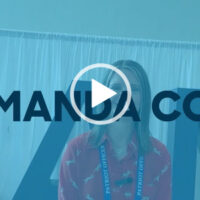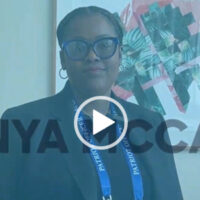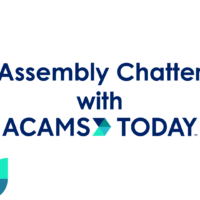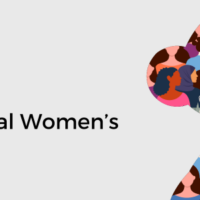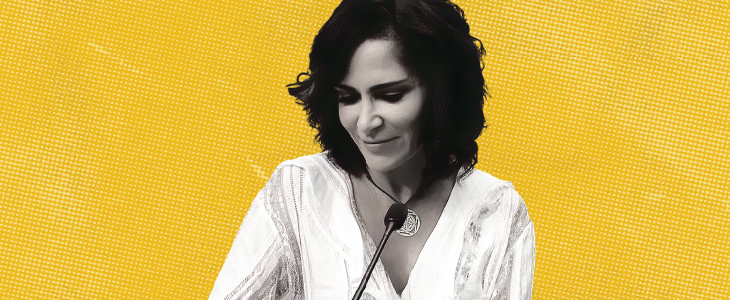
ACAMS Today sat down with Lydia Cacho at the ACAMS 17th Annual AML & Financial Crime Conference in Las Vegas, Nevada to discuss her lifetime commitment in the fight for human rights, her career as an investigative journalist, her views on human trafficking (HT) awareness and much more.
Lydia Cacho Ribeiro has received notable recognition for traveling around the world investigating crimes and developing new social tools to confront complex problems. She has used her experience to become an author, an international reporter of human rights, and a well-recognized founder of shelters for women and children victims of gender violence including sexual violence and HT. Her approach to teaching new skills to confront HT and slavery around the world has gained her several awards and international prizes.
Cacho’s knowledge of different law systems, psychology, criminology and pedagogy has led her to develop gender perspective workshops for police, members of the judicial system and intelligence specialists.
Cacho is quite critical of the Mexican justice system and of the flaws in international laws against HT. Nevertheless as a founder of a high security shelter in Mexico, she demonstrates how victims can become survivors and how civil society can transform the system to promote integral human rights against organized crime culture. Her work shows that pursuing the truth is needed around the world to stop gender-based violence. Thanks to her efforts, she achieved a life sentence (113 years) for an international child pornography producer and sex trafficker of children operating in Mexico and the U.S. It was the first sentence of its kind in Latin America.
Her ample knowledge has led her to write 12 books, from poetry to fiction, a manual to prevent child abuse, essays on gender issues, non-fiction on child slavery for the drug industry and her international best-sellers on sex trafficking, human slavery and child pornography, such as Slavery Inc. Her books have been translated into French, English, Dutch, Portuguese, Italian, German, Croatian, Swedish and Turkish; and have been published from Mexico to Spain, Argentina and Colombia, and all over Central America.
ACAMS Today: As an international reporter, what drew you to report on human rights?
Lydia Cacho: I was a human rights activist before I knew that I would become a journalist. My mom was a psychologist and she used to work with women in Mexico and with a lot of nongovernmental organizations (NGOs). So, when I was 15 years old, I started working with my mom. She would take me, my sisters and my brothers to work with her. So, as kids we became activists.
Also, I started doing investigative reporting when I was 23 years old. Reporting came naturally to me because of what was ingrained in me at an early age which guided my understanding of human behavior and life. This is the perspective I gained as a teenager and I have never lost it. Of course, 30 years ago it did take me a while to convince my editors that it was worth it to write about violence against women. My editors would tell me that those topics were private issues and that a reporter should not be involved with or even investigate these types of topics. They did not even want me to investigate Pablo Escobar’s presence in Quintana Roo. At that time, my editors did not want me to cover these stories because they believed these themes had to do with police work and not investigative journalism. Early in my career, I guess you can say I broke a lot of barriers. I was always looking at stories from the victim’s perspective, but also investigating the psyche of the batterers from a human rights perspective.
AT: You have created shelters for women and children who have been victims of gender violence. What led you to create the shelters and what services do they provide to the victims. Also, are the shelters global?
LC: The shelters are in Mexico and they provide services and personal security for the women and children. We start by doing a risk assessment of each individual that we rescue from different areas in Mexico. We also provide psychological support for victims of sexual trafficking and violence.
We provide these women and children with housing. Also, the difference between the shelters in Mexico and the U.S. is that the shelters have highsecurity and are located in an undisclosed area. Another difference is we have a public office or assistance center where women first call if they need assistance. In addition, we also provide legal assistance. Sometimes the legal defense for some of the women in the shelter can last up to three years or more. Another service we provide is job training, which helps the women change the patterns of HT violence or domestic violence. One of the reasons why victims end up or are stuck in HT is because they have no other options. One of the perspectives of our model in the shelters is to provide job training to help change the survivors’ economic status. The job-training program helps our survivors feel empowered and it teaches them how to conduct themselves in a professional business environment. Women come into the shelter and tell us the type of job they would like to do and we teach them the skills on how to acquire a job so once they leave the shelter they always have a job.
Another great thing about the shelter in Mexico is we have agreements with the hotel industry. These agreements help us connect the women from our shelter to jobs in hospitality and the local hotels have done a good deed for their community. Also, through this agreement we have received feedback from the local hotels and restaurants that tell us that every woman that arrives from the shelters are excellent workers. Through these employment opportunities, women have regained their freedom.
Another service we offer through the model we have developed is education for the children that arrive at the shelter. We have received awards for the peace education model we developed. The peace education class teaches the children to mediate when they have a crisis or experience violence with other children. As we all now know, when children have experienced or lived with violence they tend to replicate violence. It becomes a cycle. So, we provide yoga classes, sports, teach them to meditate, etc. We need to give the children tools or educate them on how differences can be mediated in order to change the violent patterns within our communities.
AT: Are there other countries or shelters that are using the shelter model you developed in Mexico?
LC: Yes. I decided to give the shelter model that I developed with my team away. I decided this because when I first opened a shelter in Mexico, I looked for other models globally and no one wanted to give away their shelter models and it was too expensive to purchase a model. In fact, I opened the first shelters with $10,000 that I had in my savings account. So, I wanted to share my shelter model with others. The shelter model that my team and I developed has been used all over Central America, the Caribbean, India, Poland, Turkey and in the U.S.
AT: How are shelters funded or where can ACAMS’ members donate to the shelters?
LC: We have created a national network of shelters where we created a model that would require everyone to have accountability and also to know from where donations are coming. Some of the bad guys try to contribute to the shelters. For example, there was a case in India where the bad guys donated money to a women’s shelter and the shelter had to close because the donated money was derived from money laundering. The bad guys donate the money to frame the shelters so the shelters will be forced to close down. This is why when I created the model for shelters in Mexico I stated the importance of accountability, transparency and knowing where the donated money comes from. Another challenge is that legal businesses want to give cash contributions to the shelter off the books and then they want receipts for tax purposes. We do not allow it. So, the question is: What do you do and how do you educate others to help them understand that NGOs also have to comply with regulations? It is difficult, but so far the shelters in Mexico have been successful and we are proud of our 36 shelters.
Other services we offer are medical services and a group of specialists that work in legislation. For example, I have traveled to Guatemala to help congress pass laws against HT. We also did this with El Salvador and Colombia. When you talk about HT and tell governments how with their help new laws can be created to tackle HT, congresses around the world get excited because they can change things.
AT: What are some of the flaws you have found in the international laws against HT?
LC: In the U.S., when the Clinton administration started their global reports on HT it was fantastic; however, I realized that they did not originally cover the U.S. until recently. I was at a conference with Hillary Clinton and I asked her why the report did not cover the U.S. She said we cover other countries and I told her that I had been to several states where women and children are being trafficked and that I could provide them with numbers from my investigations. Another thing I realized, in visiting Germany and the Netherlands to speak about my book Slavery Inc., is that not only the U.S., but also these two countries have legalized prostitution or sexual commerce. These two countries have noticed that the quantity of young women and young men that have been trafficked to their countries to be exploited in the black market has increased. Which proves what we have been telling countries for the last 15 years. If you legalize prostitution, organized crime will find a way to make HT victims more expensive for clients. For example, if an American businessman goes to the red light district in the Netherlands, he will see a woman that is 30 years old and looks great. He knows that this woman has been trained to work in prostitution, but what he really wants is not a woman that perhaps looks like his wife, rather he wants someone that is interesting, different and exotic. So, what the Johns do is they will either ask taxi drivers or the bellhops at hotels where they can get an exotic girl or boy. Unfortunately, the Johns always find the girls or boys and they drive up the demand in the market for exotic victims.
This demand is one of the reasons, for example, that Germany is questioning their prostitution laws and Germany is now trying to imitate the law from Sweden. The law in Sweden is globally important because the Swedish law decriminalizes the victim/prostitute and criminalizes the buyer. As a result, the Swedish law has dramatically changed the rights of the victims. The Netherlands and Japan have followed the example of the Swedish law and HT patterns have changed. Things are changing within HT because we have moved from focusing solely on the victims to focusing on the clients to see who is creating the HT demand in the market.
The same people who are doing the money laundering are subletting their trails
to human traffickers and smugglers
AT: How does HT and combating HT differ around the world?
LC: HT is globally all linked together. We need to work together as an international community. First, you need an international umbrella of laws and regulations. If you understand the laws and regulations and comply with them, then you need to form networks with other countries and NGOs to work together to combat HT.
We also need to review legislation regularly for change to occur as previously mentioned with Sweden and the Netherlands.
Another important aspect is to link together money laundering, drug trafficking and HT. Why? Because the same people who are doing the money laundering are subletting their trails to human traffickers and smugglers. Networking together globally will make a huge difference.
AT: What else can we do as financial crime prevention professionals to combat HT?
LC: Sharing information is important as discussed during this conference. I have all these names of businessmen who are linked to HT, but also to illegal businesses that I would like to share. In one of my books, I discuss the case of a businessman who was a partner at a casino and was also linked to child pornography in Mexico. We have recordings where he ordered a 13-year-old virgin from Florida. This man is originally from Lebanon and he has businesses all over the world. What I discovered while I was investigating is that he made most of his money from sweatshops. I went to one of these sweatshops and discovered that they were manufacturing toys for Disney. Do you see the irony? So, what I did next was to contact these amazing NGOs that work to prevent slavery in the manufacturing industry. The NGOs sent all the documentation they had to Disney. Disney cancelled its deal with this man. As a result of my investigation, the businessman took me to court and stated that I had made him lose more than $25 million. I told him to prove it and to file an injunction. Of course, he could not do it because all of this money was going through other countries, including the U.S. and if he did, this would be public record and I would be able to go after him for money laundering. The important thing to remember is that we should all work together to stop these criminals.
AT: During your keynote address at the ACAMS Vegas conference, you recommended that the anti-financial crime community network with local journalists. What knowledge can the anti-financial crime community provide to journalists?
LC: If a reporter is not looking for you, you should look for them, specifically if you have a case that is being covered by a reporter or a newspaper. Reporters are always looking for experts when writing or covering a story. As an expert, you can help the reporter with facts by sharing your expert knowledge. By working together, we can tell the world that things are changing in the fight against crime.
AT: As a follow up to the question above, as financial crime prevention professionals there are things we cannot share due to privacy policies and regulations. What recommendations do you have when this occurs for the anti-money laundering professional and reporter partnership?
LC: Let me give you an example from this conference. One of the presenters said during their presentation that if we wanted to know more about the case they were speaking about, then we should go to the public record, because in that record you can find more information. This is an example of how you can assist journalists—by guiding them to legal resources.
AT: You reported earlier on the full circle that is driving HT from Asia to Latin America, because of regulations and the way that Hispanic women are viewed. How can the Latin American community create awareness for younger generations about HT while changing the cultural perception of women in these countries?
LC: Parents are afraid of HT happening to their children. If parents let their fear of HT drive them, then their message to their children of having power over their own bodies weakens.
I wrote two children’s books where I talk about adults and what happens as a result of their fear, specifically in my book In search of Kayla (En busca de Kayla). Kayla discovers that a girl in her school is missing and the adults become frozen by fear because they cannot believe this has happened. Kayla, with the help of other children, discovers that the girl was groomed on Facebook and with the assistance of the police they rescue the girl that was taken. This book has become a best-seller and when my publisher asked me why I thought that this book became a best-seller, I told my publisher that children are moved by books that tell them they are intelligent and brave. As a parent or an adult, all you want to do is protect children from being exposed to HT, but what adults are failing to do is to explain to children the realities that are out there (i.e., pornography) which children are being exposed to every day and as a result parents are not empowering their children. I would encourage parents to empower their children through speaking to them about the realities they may face.
I created a platform that can be used at schools or with your children on how to talk about human exploitation issues. The series is called Somos Valientes and you can go to SomosValientes.mx to view the series and also to donate to help us continue to develop these awareness tools and platforms for children.
AT: What inspires you to keep moving forward with the human rights work that you do?
LC: I can see the results of my work and how it impacts society. Also, freedom is so powerful. When you are free, you want to share it with the world and let everyone know how important it is to be free. Also, I remember a long time ago when I got out of jail, a reporter from the Washington Post wrote a headline on the front page of the Post saying that I was the “rock star of Mexican journalism.” I felt self-conscious about this statement for a long time, until one day I was speaking at a school and when I finished all the children gave me a standing ovation. They came over to speak with me and they all said that they wanted to be like me. That day I went home and I thought if these children want to follow my example instead of the example of a Chapos’ man, then I will always use the “rock star” kind of fame to make an impact on society.







